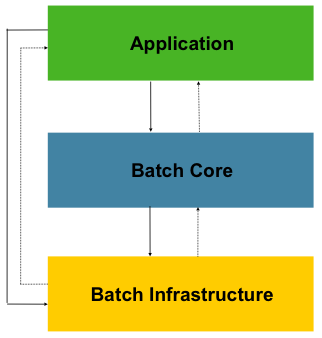

Many applications within the enterprise domain require bulk processing to perform business operations in mission critical environments. These business operations include automated, complex processing of large volumes of information that is most efficiently processed without user interaction. These operations typically include time based events (e.g. month-end calculations, notices or correspondence), periodic application of complex business rules processed repetitively across very large data sets (e.g. Insurance benefit determination or rate adjustments), or the integration of information that is received from internal and external systems that typically requires formatting, validation and processing in a transactional manner into the system of record. Batch processing is used to process billions of transactions every day for enterprises.
Spring Batch is a lightweight, comprehensive batch framework designed to enable the development of robust batch applications vital for the daily operations of enterprise systems. Spring Batch builds upon the productivity, POJO-based development approach, and general ease of use capabilities people have come to know from the Spring Framework, while making it easy for developers to access and leverage more advance enterprise services when necessary. Spring Batch is not a scheduling framework. There are many good enterprise schedulers available in both the commercial and open source spaces such as Quartz, Tivoli, Control-M, etc. It is intended to work in conjunction with a scheduler, not replace a scheduler.
Spring Batch provides reusable functions that are essential in processing large volumes of records, including logging/tracing, transaction management, job processing statistics, job restart, skip, and resource management. It also provides more advance technical services and features that will enable extremely high-volume and high performance batch jobs though optimization and partitioning techniques. Simple as well as complex, high-volume batch jobs can leverage the framework in a highly scalable manner to process significant volumes of information.
While open source software projects and associated communities have focused greater attention on web-based and SOA messaging-based architecture frameworks, there has been a notable lack of focus on reusable architecture frameworks to accommodate Java-based batch processing needs, despite continued needs to handle such processing within enterprise IT environments. The lack of a standard, reusable batch architecture has resulted in the proliferation of many one-off, in-house solutions developed within client enterprise IT functions.
SpringSource and Accenture have collaborated to change this. Accenture's hands-on industry and technical experience in implementing batch architectures, SpringSource's depth of technical experience, and Spring's proven programming model together mark a natural and powerful partnership to create high-quality, market relevant software aimed at filling an important gap in enterprise Java. Both companies are also currently working with a number of clients solving similar problems developing Spring-based batch architecture solutions. This has provided some useful additional detail and real-life constraints helping to ensure the solution can be applied to the real-world problems posed by clients. For these reasons and many more, SpringSource and Accenture have teamed to collaborate on the development of Spring Batch.
Accenture has contributed previously proprietary batch processing architecture frameworks, based upon decades worth of experience in building batch architectures with the last several generations of platforms, (i.e., COBOL/Mainframe, C++/Unix, and now Java/anywhere) to the Spring Batch project along with committer resources to drive support, enhancements, and the future roadmap.
The collaborative effort between Accenture and SpringSource aims to promote the standardization of software processing approaches, frameworks, and tools that can be consistently leveraged by enterprise users when creating batch applications. Companies and government agencies desiring to deliver standard, proven solutions to their enterprise IT environments will benefit from Spring Batch.
A typical batch program generally reads a large number of records from a database, file, or queue, processes the data in some fashion, and then writes back data in a modified form. Spring Batch automates this basic batch iteration, providing the capability to process similar transactions as a set, typically in an offline environment without any user interaction. Batch jobs are part of most IT projects and Spring Batch is the only open source framework that provides a robust, enterprise-scale solution.
Business Scenarios
Commit batch process periodically
Concurrent batch processing: parallel processing of a job
Staged, enterprise message-driven processing
Massively parallel batch processing
Manual or scheduled restart after failure
Sequential processing of dependent steps (with extensions to workflow-driven batches)
Partial processing: skip records (e.g. on rollback)
Whole-batch transaction: for cases with a small batch size or existing stored procedures/scripts
Technical Objectives
Batch developers use the Spring programming model: concentrate on business logic; let the framework take care of infrastructure.
Clear separation of concerns between the infrastructure, the batch execution environment, and the batch application.
Provide common, core execution services as interfaces that all projects can implement.
Provide simple and default implementations of the core execution interfaces that can be used ‘out of the box’.
Easy to configure, customize, and extend services, by leveraging the spring framework in all layers.
All existing core services should be easy to replace or extend, without any impact to the infrastructure layer.
Provide a simple deployment model, with the architecture JARs completely separate from the application, built using Maven.
Spring Batch is designed with extensibility and a diverse group of end users in mind. The figure below shows a sketch of the layered architecture that supports the extensibility and ease of use for end-user developers.

Figure 1.1: Spring Batch Layered Architecture
This layered architecture highlights three major high level
components: Application, Core, and Infrastructure. The application
contains all batch jobs and custom code written by developers using Spring
Batch. The Batch Core contains the core runtime classes necessary to
launch and control a batch job. It includes things such as a
JobLauncher, Job, and
Step implementations. Both Application and Core are
built on top of a common infrastructure. This infrastructure contains
common readers and writers, and services such as the
RetryTemplate, which are used both by application
developers(ItemReader and
ItemWriter) and the core framework itself.
(retry)